Sebuah Diagram Interrelasi adalah tampilan visual yang memetakan hubungan sebab dan akibat di antara masalah kompleks yang melibatkan banyak variabel atau hasil yang diinginkan. Dengan koneksi yang terhubung, Anda dapat menganalisis hubungan sebab dan akibat yang ada di antara semua faktor dalam situasi kompleks, yang pada akhirnya memungkinkan Anda untuk mengembangkan solusi yang efektif untuk masalah tersebut. Anda dapat menghubungkan lebih dari satu faktor secara logis sekaligus. Dengan demikian, proses ini mendorong Anda untuk berpikir dalam berbagai arah alih-alih berpikir secara linier. Setelah semua koneksi relevan antara item telah digambar, koneksi tersebut dihitung. Mereka yang memiliki koneksi terbanyak biasanya akan menjadi faktor terpenting untuk difokuskan.
Kapan Menggunakan Diagram Interrelasi?
- Mendorong Anggota Tim Untuk Berpikir Dalam Berbagai Arah Alih-Alih Secara Linier
- Mengeksplorasi Hubungan Sebab Dan Akibat Di Antara Semua Masalah, Termasuk Yang Paling Kontroversial
- Memungkinkan Masalah Kunci Muncul Secara Alami Alih-Alih Dipaksa Oleh Anggota Tim Yang Dominan Atau Kuat
- Secara Sistematis Mengungkapkan Asumsi Dasar Dan Alasan Untuk Ketidaksepakatan Di Antara Anggota Tim
- Memungkinkan Sebuah Tim Untuk Mengidentifikasi Akar Penyebab Meskipun Data Yang Kredibel Tidak Ada
Langkah-langkah untuk Membuat Diagram Interrelasi
Untuk membuat Diagram Interrelasi, penting untuk menulis pernyataan yang mendefinisikan isu dari masalah yang akan dieksplorasi. Anggota tim perlu melakukan brainstorming ide dan menuliskannya di sekitar isu utama. Setelah ide-ide tersebut ditempatkan pada isu, hubungkan ide-ide tersebut menggunakan panah untuk menetapkan hubungan mereka.
Untuk membuat Diagram Interrelasi:
- Identifikasi isu atau pertanyaan.
- Tambahkan isu / pengaruh / Penyebab masalah
- Bandingkan setiap elemen dengan semua elemen lainnya. Gunakan panah ‘pengaruh’ untuk menghubungkan elemen yang terkait.
- Panah harus digambar dari elemen yang mempengaruhi elemen yang dipengaruhi.
- Jika dua elemen saling mempengaruhi, panah harus digambar untuk mencerminkan pengaruh yang lebih kuat.
- Hitung panahnya.
- Elemen dengan panah keluar terbanyak akan menjadi akar penyebab atau penggerak.
- Yang memiliki panah masuk terbanyak akan menjadi hasil atau keluaran kunci.
Contoh Diagram Interrelasi — Waktu Tunggu Tinggi untuk Bus
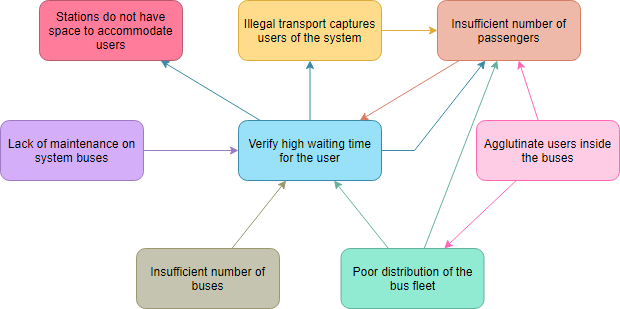
*Sumber: whatissixsigma.net
Analisis Diagram
- Hitung Jumlah Panah Input Dan Output (Input/Output) Di Setiap Kartu Dan Catat Di Salah Satu Sudutnya.
- Jika Sebuah Elemen Menyebabkan Banyak Elemen Lain: Ini Adalah Penyebab Utama.
- Jika Sebuah Elemen Dihubungkan Oleh Banyak Panah: Itu Mewakili Efek Akhir.
- Elemen-elemen Yang Mengumpulkan Banyak Panah Masuk Dan Keluar: Mereka Adalah Elemen Kunci.
Contoh Diagram Interrelasi — Pengiriman Produk Komunikasi Buruk
Contoh ini diambil dari *Benbow dan Kubiak pada tahun 2005). Sekarang, mari kita tafsirkan makna dari diagram tersebut, jadi, apa faktor kunci atau penyebab yang perlu diselidiki dan diperbaiki?
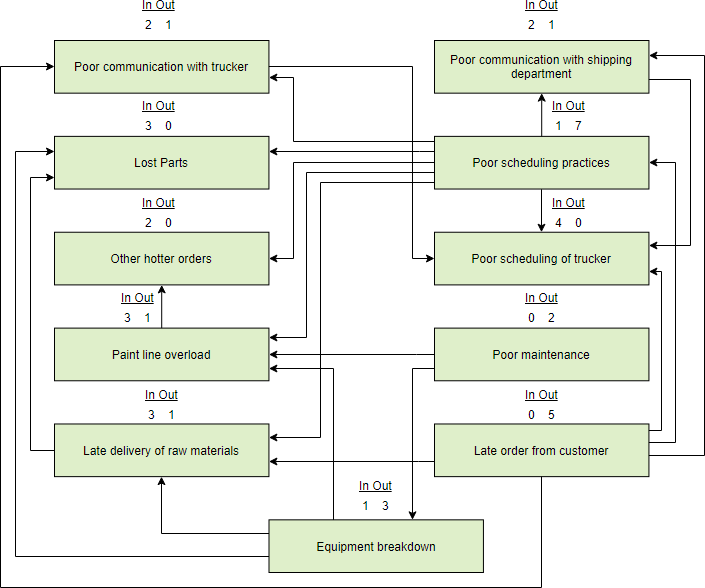
Ingat bahwa:
Identifikasi Penyebab Kunci (Penggerak)
Kami menyebut entri dalam digraf sebagai perhatian.Sebuah perhatian dengan jumlah panah keluar yang tinggi adalah penggerak atau penyebab kunci. Sebuah penyebab kunci mempengaruhi sejumlah besar item lainnya. Diagram di atas menunjukkan penyebab kunci berikut:
- ‘Praktik penjadwalan yang buruk’ (6 panah keluar),
- ‘Pesanan terlambat dari pelanggan’ (5 panah keluar), dan
- ‘Kerusakan peralatan (3 panah keluar).
Identifikasi Perhatian Kunci
- Sebuah Perhatian Dengan Jumlah Panah Masuk Yang Besar Dipengaruhi Oleh Banyak Perhatian Lain. Dengan demikian, Ini Bisa Menjadi Sumber Ukuran Kualitas Atau Kinerja.
- ‘Jadwal Buruk Truk’ Memiliki 4 Panah Masuk.
- Sebuah Ukuran Kinerja Penjadwalan Buruk Truk Dapat Menunjukkan Besarnya Masalah Sistem Yang Menyebabkan Pengiriman Terlambat.
- Benbow, D. W., dan T. M. Kubiak — Buku Panduan Sabuk Hitam Six Sigma Bersertifikat. Milwaukee, Wisconsin, ASQ Quality Press pada tahun 2005.
Contoh:
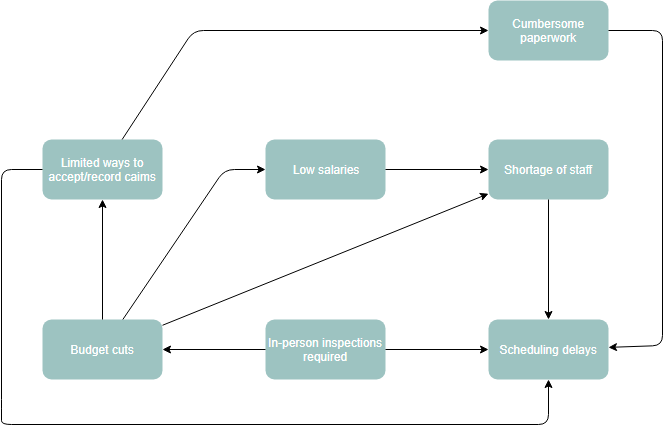
Contoh Diagram Hubungan — Program Perubahan Korporat
Berikut adalah contoh dari sebuahdiagram hubunganyang dibuat untuk membantu tim mengidentifikasi mengapa inisiatif perubahan dalam sebuah organisasi gagal memberikan manfaat yang diharapkan. Secara opsional, diagram dapat menempatkan total panah masuk dan keluar di atas setiap item.
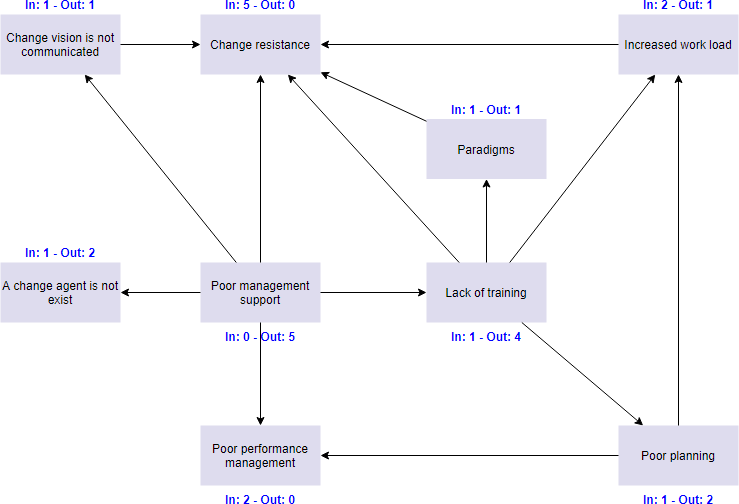
Contoh Diagram Hubungan Bisnis
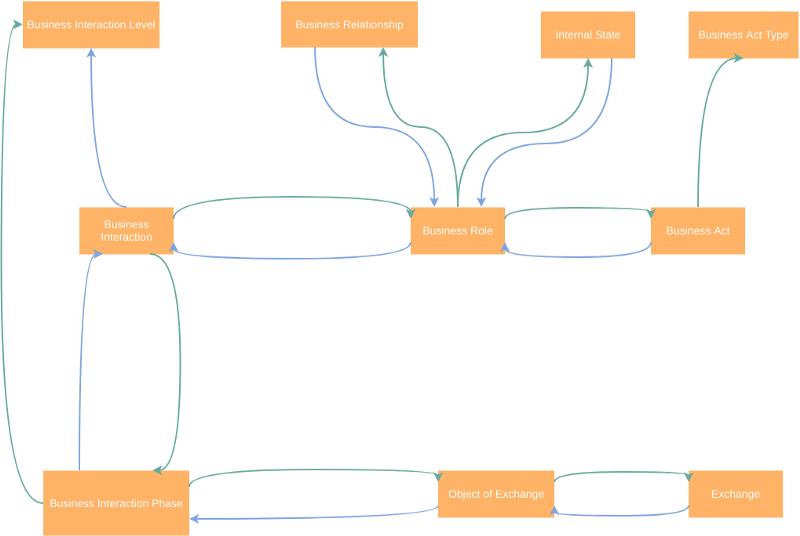
Contoh Diagram Hubungan — Rumah Sakit Kecil
(*Sumber — Panduan Analisis Bisnis PMI)
Sebuahrumah sakit kecilkhawatir tentang produktivitas dokternya karena mereka adalah karyawan termahal dan sangat penting untuk perawatan pasien. Setelah mengambil berbagai langkah untuk memastikan produktivitas tinggi, manajemen rumah sakit bingung ketika produktivitas terus menurun bulan demi bulan.
Karena perkembangan ini tidak dapat dijelaskan, manajemen berusaha untuk mendapatkan wawasan tentang penyebab dan efek di antara berbagai faktor yang berperan. Mereka memutuskan untuk membuat diagram hubungan dan memasukkan faktor-faktor berikut dalam analisis:
- Jumlah Janji Temu yang Dijadwalkan Per Dokter
- Jumlah Janji Temu Darurat Per Dokter
- Beban Kerja Administratif Per Dokter
- Jumlah Perubahan Dalam Janji Temu yang Dijadwalkan
- Kualitas dan Keandalan Peralatan
- Ketersediaan Perawat
- Ketersediaan Fungsi Dukungan Lainnya
- Tingkat Gaji Dokter
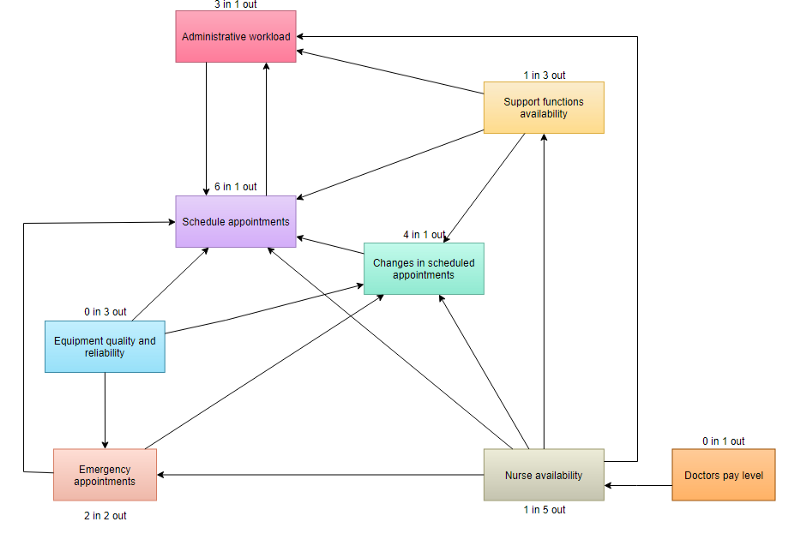
Menginterpretasikan Hasil Diagram
Jumlah panah keluar yang tinggi menunjukkan bahwa suatu masalah adalah penggerak atau kemungkinan penyebab utama. Tim umumnya mengevaluasi masalah ini terlebih dahulu untuk mendapatkan hasil yang paling luas. Jumlah panah masuk yang tinggi menunjukkan bahwa suatu masalah adalah hasil. Masalah ini dapat berfungsi sebagai ukuran penting keberhasilan.
- Hitung Panah Masuk dan Keluar untuk Setiap Ide. Tulis Jumlahnya di Bagian Bawah Setiap Kotak. Yang Punya Paling Banyak Panah adalah Ide Kunci.
- Catat Ide-Ide Mana yang Memiliki Panah Keluar (Dari) Utama. Ini adalah Penyebab Dasar atau Penggerak.
- Catat Ide-Ide Mana yang Memiliki Panah Masuk (Ke) Utama. Ini adalah Efek Akhir yang Juga Mungkin Penting untuk Ditangani.
- Pastikan untuk Memeriksa Apakah Ide-Ide dengan Lebih Sedikit Panah Juga Merupakan Ide Kunci. Jumlah Panah Hanya Sebuah Indikator, Bukan Aturan Mutlak. Gambar Garis Tebal di Sekitar Ide-Ide Kunci.
This post is also available in Deutsch, English, Español, فارسی, Français, 日本語, Polski, Portuguese, Ру́сский, Việt Nam, 简体中文 and 繁體中文.













